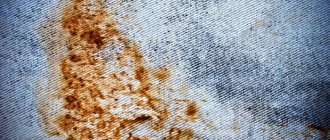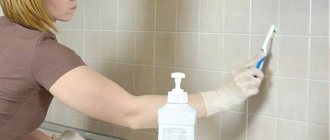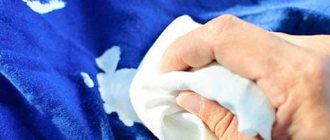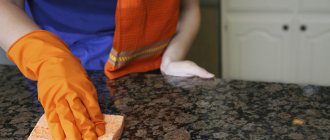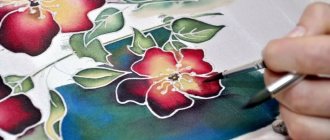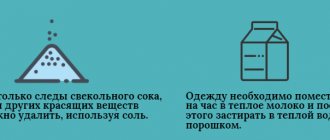Any experienced housewife knows that it is not enough to just look into an online women's clothing store and place an order. But also that methods for cleaning stains vary greatly (sometimes dramatically) depending on their origin. If blood, sweat, fruit or berry juice, paint or grease particles have come into contact with a wardrobe item or textile product, cleaning methods will differ. Today’s article will talk about removing a variety of problematic contaminants.
We will tell you how to remove dirt from colored clothes and white things. The basic rule is to clean the stains fresh. Try to get rid of any dirt that has appeared as quickly as possible so as not to waste time looking for ways to clean up various old traces. Be aware: pre-soaking is not always a necessary step.
Tough stains
If untidy marks on clothes are discovered late, it will be much more difficult to wash them and you will have to put in more effort. Such contaminants are called difficult to remove. Sometimes you have to use strong bleaches to eliminate them, and in some cases only proven folk remedies help, because you don’t want to throw away your favorite things.
There are several types of stains that are very difficult to wash off. This category includes stains from:
- sweat;
- food;
- herbs;
- cosmetics;
- paints;
- blood.
Difficult to remove food stains can be divided into several categories. These are untidy blots from vegetables or fruits, drinks, fatty meat dishes. This also includes any derivative products:
- coffee;
- wine;
- sauce;
- jam;
- ketchup;
- jam;
- juice.
Food stains are easily removed at the very beginning. The more time passes from the moment they appear, the more difficult it will be to clean things up. Before choosing a method to eliminate the problem, you need to determine the type of fabric, the type of stain and the period during which the stains remained on the clothing. After studying the product label, it will be clear what types of processing are acceptable.
Two most important rules
Before you wash stubborn stains, you need to pay attention to several important nuances. Firstly, no product is universal, that is, it is impossible, for example, to remove stains on silk and burlap using the same chemical. Secondly, it is necessary to establish the nature of the pollution in order to choose the optimal method to combat it.
What does this look like in practice?
Features of the material
It is imperative to understand what material you are dealing with and understand the composition of the fibers.
All this information should be indicated on the label; there are also tips on washing (hand/machine; maximum permissible temperature) and care (is ironing allowed, is it permissible to use bleaches). The most difficult thing to deal with is traces of old dirt on such delicate and “complex” materials as silk, velvet, gauze, chiffon, jacquard, nylon, viscose, etc. They absolutely do not tolerate chlorine bleaches, hot water and intensive washing. They also ambiguously apply to some folk remedies for removing stains.
How do you know that the product you choose (homemade or store-bought) will not harm the fabric? Before soaking the entire item in it, you should test it on an inconspicuous area (inner seam) and wait for the fabric to react. If the material does not deform and the color does not change, then it can be used.
In addition, it is also important that colored or white clothes need to be cleaned. For example, hydrogen peroxide is great for white clothes, but this chemical compound can ruin a bright dress. And on the contrary, some products work well in the case of colored clothes, but snow-white linen turns yellow or darkens.
Origin of pollution
Another point to consider when dealing with stains is the nature of the stain. The problem will be solved if the stain remover can enter into a chemical reaction with dirty marks. For example, fuel oil is removed from clothing using purified gasoline, and blood is removed using ammonia.
But let's find out what types of pollution are considered difficult to remove. This group includes traces from:
- blood;
- green grass;
- sweat discharge (especially if the item is not washed immediately);
- paints;
- fuel oil (bitumen, machine oil);
- some food products;
- ink;
- brilliant green, methylene blue;
- rust.
Old and complex food stains are conventionally divided into several subgroups. And each of them will have to be fought using special means.
Photo: https://pixabay.com/photos/red-wine-spill-spot-glass-red-505296/
What products leave stubborn stains on clothes? This:
- fat and oils;
- coffee;
- red wine;
- some fruits and vegetables (blueberries, currants, beets, etc.);
- jam and jam from some fruits;
- ketchup;
- tomato paste;
- juices from dark berries and fruits.
In addition, the “age” of the contamination is also important. The faster you start fighting stains, the easier it will be to get rid of them. And vice versa: old traces of almost any origin are much more difficult to remove. You will have to resort to aggressive means, and this increases the risk of ruining the item.
How to remove a stubborn stain
To remove stubborn stains from velor, cotton, wool without ruining the item, you should conduct a small test before starting treatment - apply the selected product to the fabric from the wrong side. After a positive experiment, remove contaminants in other places. Spots that have a large area are treated from the edges to the middle to prevent streaks from appearing.
You should definitely try to remove dirt using a liquid or powder stain remover, if there is no prohibiting sign on the label, and then try other methods. It is easier to choose the appropriate cleaning method if you study the table of effective means:
Oil, paint, dried dirt
Grass, sweat, ketchup, clay
Rust, blood, old dirt
Citric acid or vinegar
Dried Blood
Dried blood stains cannot be removed by simple washing. The best way to remove such contaminants is ammonia. You need to moisten a cotton pad in this product, carefully apply it to the blood stains from the edges to the middle, and leave on the fabric for 5-8 minutes. After this, the composition is washed off with water, which has a temperature of 30–35 degrees.
Old dirt
If dirt gets on your laundry, you can remove it by following the instructions:
- Grate laundry soap on a coarse grater.
- Add 2 tbsp. l. boiling water
- Stir until gel-like.
- Wet the stains with water.
- Apply to dirt and leave for 15–18 minutes.
- Rinse 1-2 times in hot water.
Traces of clay, fuel oil or grass on children's clothing are removed in the same way. White cotton linen can be washed well with Whiteness bleach, but first you should make sure that it is suitable for this type of fabric. If dirty traces of plant origin are not eliminated from the first dose, then you need to add 2 aspirin tablets or 2 tsp to the laundry soap. hydrogen peroxide.
From sweat
Untidy traces of sweat are visible on any clothing. To eliminate them, you will need a stain remover that can cope with such stains. Another method of getting rid of such stains is ethyl or ammonia. This method is not suitable for white clothes, because wool and silk items turn yellow after processing. Products made from natural fabrics of other colors are processed in the following way:
- Place a waffle towel under the stain.
- Alcohol is applied to a cotton swab and the stained areas are treated.
- After 10 minutes, items can be washed by hand with powder.
- If traces still remain, then repeat the procedure.
You can use another method to remove stubborn stains from sweat on things made of synthetic fabric:
- Mix one teaspoon each of salt and baking soda.
- Add 1 tbsp. l. dishwashing detergent.
- Apply to stained area for 15–20 minutes.
- Rinse under running water.
Paint and ink
To remove old stubborn stains from ink or paint, you need to mix 1 teaspoon of ammonia and glycerin. Spread the solution on the stain and wait 12–15 minutes. Rinse and repeat the procedure until the stains are completely gone. After this, the items can be placed in the washing machine, selecting a mode with a temperature of 50–60 degrees.
Oily stains
It will be more difficult to remove greasy marks than other types of dirt, so it is recommended to pre-soak things in hot water using Fairy or Drop detergent. After this you can start removing:
- Take purified gasoline or white spirit.
- Pour a small amount onto the contaminated area.
- Sprinkle chalk or talc on top.
- Distribute evenly with a toothbrush.
- Microwave for 1–1.5 minutes.
- Wash in warm water with laundry soap.
Food stains
A mixture of table vinegar and citric acid works well to remove food stains. Stains are removed according to the instructions:
- Mix lemon juice and vinegar in equal proportions - 1 tablespoon each.
- Pour the mixture onto dirty clothes.
- Wait 10–15 minutes.
- Place items in a quick wash at 40–45 degrees.
How to remove using folk remedies?
There are folk remedies that can be called universal. With their help you can get rid of any types of stains. The compounds are safe for most materials if used correctly:
Hydrogen peroxide .
This cheap product works great on animal stains. Peroxide quickly removes traces of sweat, blood, fat and more. The substance has a bleaching effect, so it should be used with caution when treating dyed fabrics.- Soda. It is used both dry and diluted. Powder is sprinkled on greasy stains, and soda paste is applied to almost any stain. You can also soak the entire item in the solution.
- Vinegar. To combat various types of stains, 9% acid is used. It can be dangerous to use more concentrated solutions on fabric.
- Ammonia . It is used both as a single agent and in combination with other substances.
How to remove street dirt stains?
Almost every person encounters dirt stains. They are dangerous because they quickly penetrate into the structure of the fabric and leave unsightly stains and marks on it that even the most expensive stain remover cannot cope with. Therefore, the main solution to help remove dirt stains will be a timely response to their appearance.
Removing stains: general recommendations
To remove marks and stains from dirt, you need to use the following general rules:
- Do not ignore contamination; immediately soak the item in soapy water or chemicals.
- Do not use vigorous scrubbing movements when trying to remove dirty marks. Such attempts lead to even greater penetration of stains into the fabric structure.
- It is recommended to use clean and soft water to rinse soiled clothing. It helps to cover the problem area and remove the resulting stains. You can determine the level of softness using soap shavings. You will need to grate half a bar of soap, combine the resulting mass with warm running water and mix the ingredients thoroughly. If the soap dissolves quickly and the water does not become cloudy, then the liquid is clean and soft. If soap shavings take a long time to dissolve and a light coating appears on the surface, this indicates the hardness of the running water. You can clean it with baking soda; to do this, just add 2-3 tablespoons of the product to a bowl of water, then mix everything.
- To better remove stains from light-colored clothes, the item must first be soaked in soapy water for 3-5 hours. The maximum time for soaking colored items is 3 hours. After this, the stains can be scrubbed off with brushes and sponges, and then put in the washing machine.
- After treatment with concentrated products, a contaminated item should be rinsed 2-3 times to remove chemical residues. This will help prevent the development of allergic reactions.
Household chemicals
Of course, a modern housewife cannot forget about chemistry when doing household chores. Chemicals make housework a lot easier. If the issue of naturalness and safety of laundry and laundry products is not so pressing for you, then you can try washing things at home in the following products:
- "White". How can you do without “Whiteness” when washing white laundry? Of course, the product is too aggressive, but the whitening effect is simply amazing. Please note right away that washing too often with “Beliznaya” will significantly reduce the shelf life of clothes and linen. “Whiteness” can be poured directly into the washing machine tank, especially if the yellowing and grayness of the laundry is not so long ago.
- "Domestos". Few people read the instructions for this product, but this is a great way to whiten washed laundry. Some housewives who know about this even add Domestos directly to the washing machine. The result will exceed all your expectations.
- Dish gel. White underwear absorbs sweat and fats as a result of constant contact with the skin. This leads to yellowing of the material. Such washed laundry can be washed with dish gel. Add some gel directly to the powder compartment.
How to remove dirt stains on clothes
Today there are many ways to help remove existing contaminants. The most popular of them are presented below:
- Borax in combination with a soda-soap solution will help remove stains on a white T-shirt. For the cleansing procedure, you need to grate a small piece of soap, add borax and soda in equal quantities, and mix all the ingredients. The resulting solution should be given time to brew, and then applied to the problem area and left for 30 minutes. After this, the clothes are rinsed in warm, clean water and sent to the washing machine.
- A weak vinegar solution also helps remove stains on white. To cope with the problem, you need to combine a spoonful of plain water and the same amount of apple cider vinegar, and mix the resulting solution. Pour the vinegar liquid into a bowl with a small amount of water and leave the dirty product in it for 30 minutes. After this, the clothes can be washed in an automatic washing machine.
- Soda ash can remove dirty marks on a down jacket or jacket. To clean, you need to add a couple of spoons of the product to the drum of the washing machine, activate the standard wash mode (with a temperature of up to 70 degrees) and wait for the process to complete.
- Potassium permanganate helps remove stains on jeans. For the procedure, you need to dissolve a few drops of the product in a bowl of water so that the water turns a little pink. Next, you need to grate half of the soap bar and pour it into the resulting liquid. Soak the dirty item in the solution for 20 minutes, then rinse and, if necessary, put it in the washing machine.
- Citric acid will help remove marks on a white jacket. To fix the problem, you will need to combine 2 spoons of the product with 1 liter of water, put soiled light-colored clothes into the resulting solution, leave them for 20 minutes and transfer them to the drum of the washing machine. You can save time and add citric acid directly to the device along with the powder. At the same time, it is recommended to wash clothes at a temperature of no more than 40 degrees.
Important Tips for Cleaning Mud
Blood prints cause a lot of problems.
Before washing, rinse it off under low-temperature running water, then place the contaminated item in a soapy solution. You can get rid of dried blood by treating it with ammonia and then washing it. Fruit and berry juice washes well the mixture, the components of which are vodka and lemon juice. We leave the composition on the dirty surface, then rinse and wash with a high-quality powder that can fight difficult stains. To remove fat from white fabric, first sprinkle starch around the greasy mark to prevent streaks from appearing.
Apply turpentine to the problem area, then wash the product as usual. It’s easy to get rid of a fresh greasy mark if you sprinkle talc on top, line it with paper and run it with a heated iron.
When you need to restore freshness to greasy collars and cuffs, ammonia will help out. If you add glycerin and water to it, you will be able to get rid of coffee, chocolate and milk traces. The composition is applied to the soiled area, after an hour the clothes are rinsed and washed.
To get rid of yellow sweat marks located in the armpits, an aqueous solution of ammonia (1 teaspoon per 1 liter of liquid) will help. After soaking the item in this mixture, simply wash it as usual. To remove paint, it is better to use a stain remover.
Enamel or other paint based on varnish will come off if kerosene or gasoline is applied to the fabric before wet cleaning. Afterwards, all that remains is to water the “disaster site” with stain remover or dishwashing liquid and put it in the washing machine.
To make stains easier to wash off, take a basin and pre-soak the soiled items. Don't forget to add washing powder when soaking. The time depends on the intensity of the contamination, so see for yourself: leave the laundry in the basin for an hour or the whole night.
To effectively clean handkerchiefs, we recommend soaking them in a strong saline solution. We keep colored items in a basin for no more than three hours, and the water should be at a low temperature. When washing, it is not necessary to use store-bought washing powder - you can prepare it yourself by mixing soda, soap and borax.
Soda ash is perfect for cleaning linen and cotton, thanks to which a product made of natural fabric looks snow-white. It can be used in an automatic machine by pouring it into a drum. When choosing a mode, set the temperature regulator to a value of no more than 70 degrees.
Important: this product is not suitable for silk and wool; the material becomes hard and brittle. Before you start wet cleaning heavily soiled items, you can use mustard paste to apply the stains and then put the item in the machine wash.
Before removing stains from white clothes, you need to learn a few important rules:
- Don't put off processing your clothes. The faster you clean things from dirt, the better the product you use will work. First, the item can be washed as usual with the addition of stain remover.
- Do not use chlorinated bleach as it will cause the fabric to turn yellow. It is best to use peroxide-based products.
- Do not soak contaminated items. This will cause the stain to become embedded in the fabric fibers.
- Keep dirty items away from warm places. Do not place it in direct sunlight or on a battery. Do not dry food marks with a hairdryer or iron.
- As a preliminary cleansing, you can use dishwashing gel. Apply it to the stain and rub lightly.
- You can mix hydrogen peroxide with liquid products and apply the resulting solution to the mark. Leave on for 20-30 minutes and rinse off.
- Do not use colored or thick products to remove marks from white items. This group includes laundry soap, mustard, kerosene, and turpentine.
- If suddenly one method does not help remove the stain, then try another. But you should not use them at the same time, as an unexpected chemical reaction may occur. It is better to repeat the procedure the next day, when the product is dry.
We suggest you familiarize yourself with How to remove stains from fruits and berries, practical tips
In some situations, in order to remove stains from white things, you need to dry clean them. This procedure may be required if traces of greasy food appear, delicate fabrics (wool, silk, cashmere) are dirty, old or stubborn stains.
Features of removing stains on denim
Denim fabric has the ability to absorb any dirt, so if you ignore the problem, you may encounter damage to your favorite things. When washing jeans, you need to remember the following rules:
- Clothes that are heavily soiled require pre-soaking. To do this, use soap shavings or any other cleaning agent. Soaking time varies between 30-60 minutes. It is not recommended to keep jeans in water any longer.
- Machine washable at temperatures up to 40 degrees, otherwise the denim may lose its shape and color.
- Stain removers and bleaches are not recommended in such cases, as they can eat away at the fabric and lead to loss of its color characteristics.
- It is recommended to wash dark jeans with a small amount of vinegar; it helps preserve the color and enhance the effect of the washing powder.
Some denim items are considered quite fragile, so it is prohibited to use aggressive chemical products for washing them. Many housewives use home methods for removing stains:
- Thoroughly rub the problem area with half a bar of laundry soap, moisten it with a small amount of water and leave the item for 1 hour. After that, it is rinsed in cool water and sent to the washing machine.
- Pour 1 spoon of turpentine into a large bowl of water and mix the ingredients. Place dirty clothes in a cup, leave for 20 minutes and rinse in clean warm water. To get rid of an unpleasant odor, the denim item is sent to the machine and washed using powder and conditioner.
- To preserve the color characteristics of the fabric, pour 2 tablespoons of apple cider vinegar into a bowl of water, soak the laundry in the resulting solution, and then wash it using an automatic washing machine.
The nuances of cleaning textiles of various colors
The choice of product for treating fabric depends on its color. Recommendations to pay attention to:
- White matter can be cleaned with aggressive compounds. She is not afraid of contact with acetone, solvent, vinegar and alcohol. Such items are soaked in bleach for as long as possible, but try to avoid using fat-based products, such as kerosene, vegetable oil or gasoline. After applying them, noticeable yellow spots will remain on the white item.
- Black fabric needs careful cleaning. To remove stains from it, gentle products are used. It is best to use substances that help fix the color: alcohol, vinegar, saline solution. Black items should be washed and soaked in cool water for a short period of time.
- Colored matter also does not tolerate contact with aggressive substances. Their choice largely depends on the strength of the dye. The weaker its adhesion to the surface, the lower the concentration of the cleaning agent should be. Such products are washed in warm, but not hot water. The average soaking time is 1 hour.
Removing old stubborn stains
Old stains are much more difficult to remove. The following methods are popular today in the fight against pollution:
- Buy Antipyatin soap at a hardware store, grate half the bar, and dissolve the resulting slurry in a bowl of water. Dirty clothes are soaked in soapy water and then rinsed under running water. If necessary, you can use machine wash.
- Jackets, blankets and furniture covers can be washed using detergents for plumbing. They contain special particles that penetrate the fabric structure and remove difficult stains. But it is not recommended to use these products for everyday items made from natural fibers. This can cause them to lose color and shape. For the cleansing procedure, you need to pour 1-2 tablespoons of the selected product into a bowl of water, leave the item in the solution for 20 minutes, and rinse it under cold water. After this, the product is sent to the machine for a more thorough wash.
- A vinegar-soda solution helps remove old stains on clothes. To do this, you need to mix 3 tablespoons of baking soda and the same amount of table vinegar in a deep cup with warm water, mix all the ingredients. Place the dirty product in the resulting mixture, hold for 20 minutes and rinse thoroughly with powder and fabric softener.
- Old marks of dirt can be removed with salt. To cleanse, take a glass of boiled warm water and 2 tablespoons of table salt. The components are mixed, the resulting solution is applied to the problem area, left for 30 minutes, after which the clothes are washed under water and, if necessary, washing powder is used.
Removing dirt from furniture upholstery
To clean furniture, you can use home methods:
- To preserve the color on the upholstery, dry cleaning with soda is used. To do this, sprinkle baking soda on the contaminated surface, leave the product for 1-2 hours, then remove it with a vacuum cleaner. If necessary, the procedure can be repeated.
- Wet soda cleaning is used to remove difficult stains. To do this, you need to moisten a soft sponge in water and walk it over the upholstery of a sofa or chair, sprinkle baking soda in an even layer on the damp surface and leave it for 20 minutes. After this, the contaminated areas are scrubbed with a sponge, and a vacuum cleaner is used on top to remove soda residues.
- Fresh stains can be removed with vinegar and dishwashing detergent. To cleanse, 1 spoon of each product is mixed and applied pointwise to the affected areas, leaving for 40 minutes. After this, the furniture is rinsed several times with a damp sponge or brush until the foam disappears.
Source of the article: https://stiralkainfo.ru/stirka/kak-otstirat-pyatna-gryazi.html
How to remove dirt stains on white and colored clothes, How to remove stubborn dirt.
Methods for dealing with old stains
The biggest problem is how to remove stubborn dirt. As a rule, advertised products do not have the desired effect. And housewives have to look for alternative ways to solve problems.
- Laundry soap or Antipyatin can be an excellent solution to almost any problem. Things need to be soaked in a soapy solution of one of these products.
- If this method does not help, then you can then soak the jacket or other clothes in water (3 l) with turpentine (1 tbsp).
- Strong and difficult to remove stains can be washed with toilet bowl cleaning products, for example, Domestos.
- Another good way is to soak for a short time in a vinegar solution. To prepare it, you need to mix 0.5 liters of water with 3 tbsp. l vinegar. Then the clothes are washed with powder and rinsed.
- Salt will also help remove dirt. To do this, in 1 tbsp. water dissolve 1 tbsp. l salt. Soak the contaminated area in the resulting solution for 15 minutes. Then wash with laundry soap and rinse.
Almost any stain can be removed. It often happens that to achieve results it is necessary to use several different products or repeat the wash 2-3 times. Over time, the dirt will come off anyway.
Source of the article: https://ruspoll.ru/pjatna/kak-otstirat-grjaz-s-beloj-odezhdy.html
Preparing clothes for washing
This is an important point on which, first of all, the quality of washing and the durability of the product depend. If everything is done correctly, then the first time you will see the desired result.
Basic rules for preparing clothes:
- Clothes should be cleaned immediately, because fresh dirt is much easier to remove.
- It is not recommended to vigorously rub the stain that has been placed. Because it can increase in size.
- The quality of water greatly influences the success of the wash. The soft one easily removes stains, while the hard one removes food residues or spilled juice very difficult. To determine the quality of water, you need to add crushed soap to it. Soft water will instantly dissolve it and remain almost transparent, while hard water will form a coating.
- Clothes wash better if you soak them first. Light-colored items can be kept in soap and water overnight. Colored fabrics should not be soaked for more than three hours.
- Before washing in the machine, you can apply a mixture of mustard and water to the problem area.
Advice! To make the water softer, you need to add a couple of tablespoons of soda.
Preliminary preparation
Proper preparation of things is half the success in the difficult fight against dirt. They can be presented as the following list:
- Don't hoard laundry for a long time. During this time, the stains have time to dry and become deeply embedded in the dirt.
- Completely fresh dirt cannot be vigorously scrubbed, as this will lead to the opposite effect: on the contrary, it will eat deeper and deeper, in direct proportion to the effort applied.
- The effectiveness of washing depends on the quality of the water: in soft water, stains literally dissolve on their own; in hard water, they are almost impossible to wash off. Finding out what kind of water is in the tap is easy. First, the soap is grated or shaved with a knife. Then a small amount of shavings is added to a container with warm water and stirred. In soft soap, the soap will dissolve quickly, but the liquid will be clear. In hard water the process will take longer. In this case, a film will appear on the surface. To soften, it is advisable to add 2 tbsp. l. soda into the washing or rinsing water.
- Soaking and pre-washing significantly improves the quality of the entire wash. White items can be left in soapy water overnight, colored items for no more than 3 hours.
- It is recommended to soak handkerchiefs in strongly salted water for several hours, and only then start washing.
- Before machine washing, you can treat stains with a mixture of mustard and water. And you need to put things away without washing off the product.
How to clean denim items
Thick fabrics do not always lend themselves well to washing. One of these is jeans. Some types of stains are very difficult to remove, but there are still ways to clean the material.
When cleaning denim items, it is recommended to follow certain rules:
- You need to soak denim items for no more than two hours, in some cases even half an hour is enough.
- The water temperature when washing should not exceed forty degrees, because things can fade.
- When washing such items, you should not use bleaching agents; they have a bad effect on the color of the fabric and the shine of the accessories.
- When cleaning blue and black jeans, you should add vinegar, this will enhance the effect of the powder.
- When washing denim, you can use ammonia and salt.
If a stain appears on your jeans that cannot be removed with warm water, then you need to proceed according to the following scheme. First, you will need to apply laundry soap to the wet area and sprinkle powder on top. After some time, soak in three liters of water with the addition of a tablespoon of turpentine. By the way, this method is suitable for removing old stains. After a couple of hours, the problem area should be thoroughly treated with a brush. At the end, the jeans should be rinsed well.
Machine washable
The machine can be used to wash bed linen made of any fabric. The main thing is to set the mode and water temperature correctly:
- for cotton, a temperature of 60 degrees is suitable;
- if it is satin or linen, then it is necessary to set it to 40 degrees;
- Silk and satin must be hand washed at a temperature of only 30 degrees.
If the laundry is not yet sufficiently dirty, you can start washing immediately. If everything is worse, then you need to pre-soak it and add a little powder. The soaking process should last about three hours.
How to remove dirt from a jacket
If stains appear on a white jacket, they must be removed as quickly as possible. After all, over time, dirt can be firmly absorbed into the fibers.
Removing traces of dirt from a jacket has several aspects:
- First of all, you need to remove any grease or other substance with a wet cloth.
- Apply cleaning agent to the fabric. It must first be tested on an inconspicuous part of the product.
- Stains should be rubbed, moving from the edges to the center, so as not to increase the dirty mark.
- Next, the jacket must be placed in the machine. If a very powerful substance was applied, it should be rinsed in cold water before machine washing.
- Before placing the jacket in the drum, it is recommended to thoroughly wash the collar and cuff area.
Before fully washing any item, it is first recommended to study the label and be sure to turn the item inside out.
Removing rust from white
It is very difficult to remove rust from white and colored linen, but you can still preserve the product by using the following methods.
First way
To carry out the manipulations, you will need a slice of lemon or lime, napkins, gauze and an iron.
The procedure is as follows:
- Place the dirty item on the ironing board.
- Place a slice of lemon or lime on the stain. And cover the top with gauze, folded in three or four layers.
- Place a napkin under the product. It will absorb traces of rust.
- Turn on the iron and wait until it gets hot. Then iron the stained areas with it.
- To complete the procedure, wash your clothes as normal.
The most effective means of combating pollution
"Vanish." A stain remover that should be applied to the problem area and left on for about 10 minutes. After time, the liquid is removed with a wet cloth.
Spray K2R. This is a product that should be sprayed onto contaminated areas; after some time it will turn into a powdery mass. The item does not need to be washed; the powder is simply wiped off from the soiled area.
Dish detergent. Apply to the soiled areas of the jacket for half an hour, then wash off with clean water.
Laundry soap. Dirty areas on the jacket should be rubbed with laundry soap and left for an hour.
Ammonia with acetone. The mixture is suitable for very coarse fabrics. It is applied with a cotton pad for no more than one minute, and then it will need to be rinsed off with plenty of water.
Shampoo or gel. These cleaning products are suitable for minor stains. After 15 minutes, wipe off with a damp sponge.
Ammonia-based product. For most fabrics, a solution of one hundred milliliters of water, a teaspoon of ammonia and the same amount of liquid soap is suitable. The resulting product needs to be foamed and applied to the dirty mark. After 15 minutes, remove with clean water.
Citric acid and salt. For different materials, you can use a mixture of salt and lemon juice. It will completely clean any thing, but not from grease.
Mustard. For dark jackets, a mushy mixture of powdered mustard and water is suitable. Apply the product in a thin layer to the fabric, and then wipe the treated area with a damp cloth.
Soda and milk. A suede jacket can be rehabilitated using a mixture of baking soda and warm milk. Apply the mushy product to the fabric and wipe off with a special sponge after drying. A jacket made of this material is easier to clean after steaming.
Vinegar. Dirty marks on bolognese jackets can be removed with vinegar. Then hang the item out in the fresh air.
Important! A leather product can be cleaned well with raw potatoes.
Dentifrice. The product is suitable for fabrics used to make jackets. Apply the powder for twenty minutes, then wash off with tap water.
Light-colored items can be cleaned with a product made from peroxide, ammonia and soda. The mixture is applied for three minutes and removed with a damp sponge.
How to remove old stains
The most difficult challenge is washing clothes with old stains. They take a lot of time and effort, and sometimes financial resources.
Modern housewives use many different methods for removing old stains:
- Antipyatnin is very popular. Dirty items should be soaked with this product before the main wash.
- For pre-soaking clothes with old stains, laundry soap or a solution of vinegar and water, in a ratio of three tablespoons per half liter, is well suited.
- Stubborn ones are treated with toilet bowl cleaning liquid before the main wash.
- Ordinary kitchen salt will also be a good help in removing difficult stains. A dirty area of fabric should be washed in a solution of a tablespoon of salt and a glass of water. Then you should wash the item using laundry soap.
If the stain does not disappear the first time, do not be upset. Perhaps another method or even several should be used.
